Processes Overview Report
The Processes Overview report provides an overview of all processes in a K2 environment.
To access the report, enter the following URL in a browser:
[Server]/Report/ProcessOverview
Enter your credentials and the report opens.
Examples of why to use this report:
- Allows you to view all processes on the server, and drill down to find data on specific process types, process instances, activities, events, and data captured by the process
- Allows you to view participants of process, the duration of a process, IPCs, and escalations.
Example
This section provides an example of the Processes Overview report.
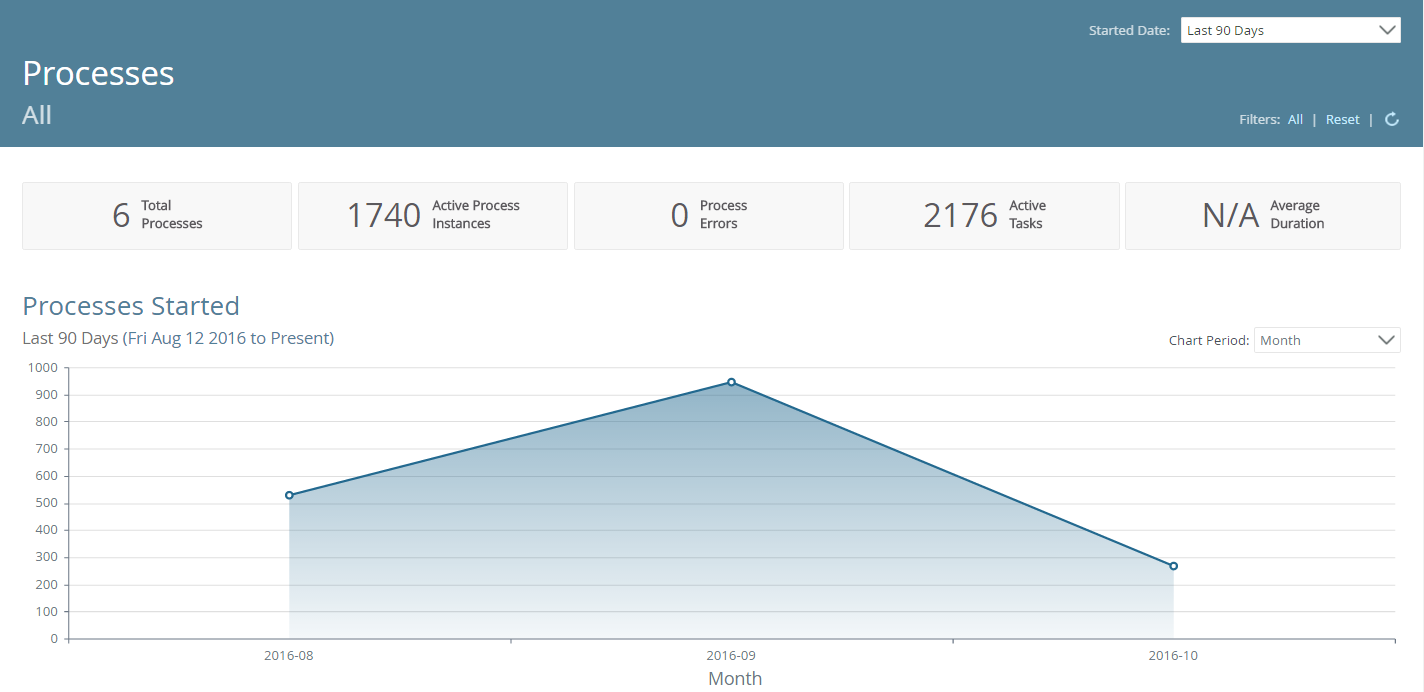
| Field | Description |
|---|---|
| Started Date | Allows you to configure the report by specifying which data is returned. By selecting a preset period of time such as the last 90 days, last year, today, and yesterday. |
|
Filters |
Allows you to filter the returned data. |
| Reset | Clicking Reset, removes the filter applied to the report. The report refreshes and the default filter is applied. |
| Refresh | Clicking Refresh refreshes the report. |
| Overview Bar | Displays an overview of total processes, active process instances, process errors, active tasks and average duration of all processes. |
| Processes Started | Displays a line graph of all started processes over a specified period. The data returned is specified by the Started Date and Filters. The returned data can be further filtered via the Chart Period by day, week and month. |
| All Processes | Displays an item list of all processes in the K2 environment. Each process is displayed by Process Name, Total Instances, Active Instances, Last Started, Last Completed, and Average Duration. You can view an individual process by clicking the name in the Process Name column which opens the Process Type Report. The data returned is specified by the Started Date and Filters. You can then filter the report by using the Quick Search or by configuring a Selected Filter. |
The following sections are available in the All Processes Overview report:
The Processes Started section displays a line graph of all started processes over a specified period. Hovering over a point on the line graph displays data by process instances started and period. The data returned is specified by the Started Date and Filters. You can filter the report section via the Chart Period by day, week, or month.

The All Processes section displays an item list of all processes in the K2 environment. Each process is displayed by Process Name, Total Instances, Active Instances, Last Started, Last Completed and Average Duration, and is sortable by clicking a column name. You can view an individual process by clicking the name in the Process Name column which opens the Process Type Report. The data returned is specified by the Started Date and Filters. You can filter the report by using the Quick Search or by configuring a Selected Filter.
By default only five processes are displayed in the All Processes section, click the > button to see more processes.

Permissions
To view the All Processes Overview report , you must have Administrator rights to view the report.
To set K2 Administrator rights, see the Server Rights topic.
Using the Report
The section below detail show to use the report, such as configuring the report via the Started Date drop-down, creating filters, and using the Quick Search.
Using the Started Date drop-down
The Started Date drop-down allows you to configure the dates of the report. Selecting an option from the Started Date refreshes the report. The report can also be refreshed via the icon. The Started Date options are determined by the culture settings in the browser settings.
Using the Filters
The Filters option allows you to specify a filter to return specified data on the report. Adding a filter to the report, will refresh the entire report with data based on the specified filter. The filter can be cleared by clicking the Reset link and the report will refresh to default settings.
Follow these steps below to configure a filter:
- Click the All link in the Filters section.

- On the Filters screen, specify the Workflows, Status and Started Date for the filter.
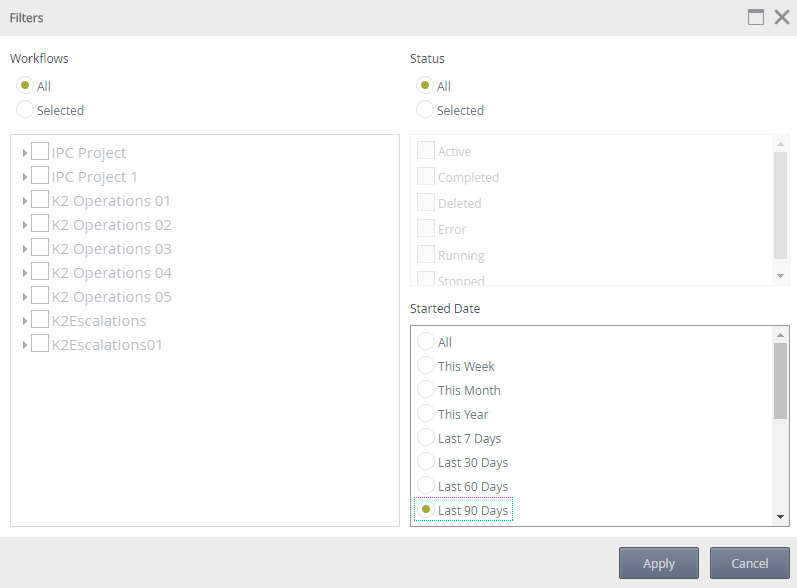 i
i
If no Workflow or Status is specified in the Filters screen, and the Apply button is clicked, the following message is displayed.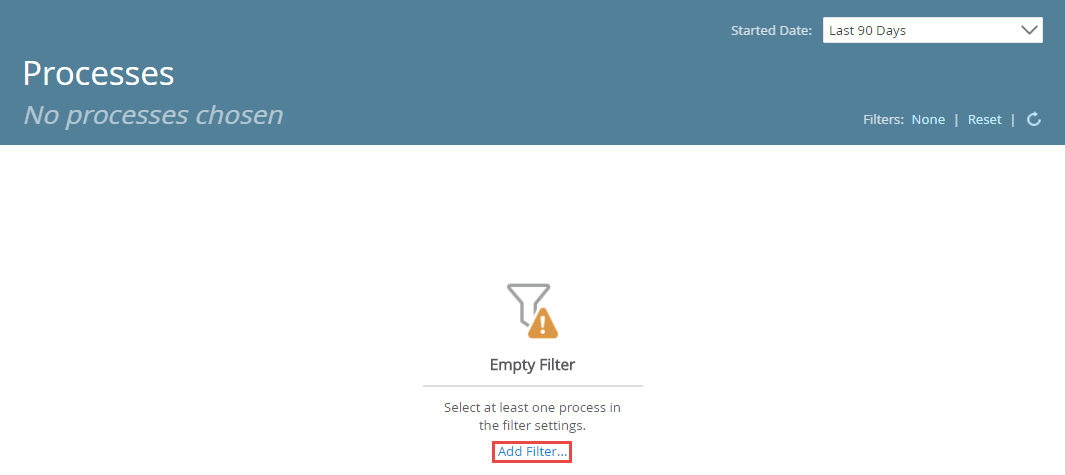
Click Add Filter... link, to add a filter. - Click Apply.
- The report will refresh and apply the filter. To remove the filter click the Reset link.
Using the Selected Filter
The Selected Filter allows you to select predefined filter or create a custom filter by clicking the custom filter icon.

Follow the steps below to create a custom filter:
- Click the custom filter icon.

- On the Configure User Filters screen, click Add.
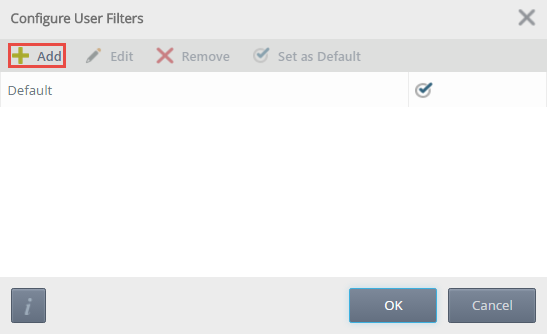
- On the Add New Filter screen, provide a filter name and click Add.
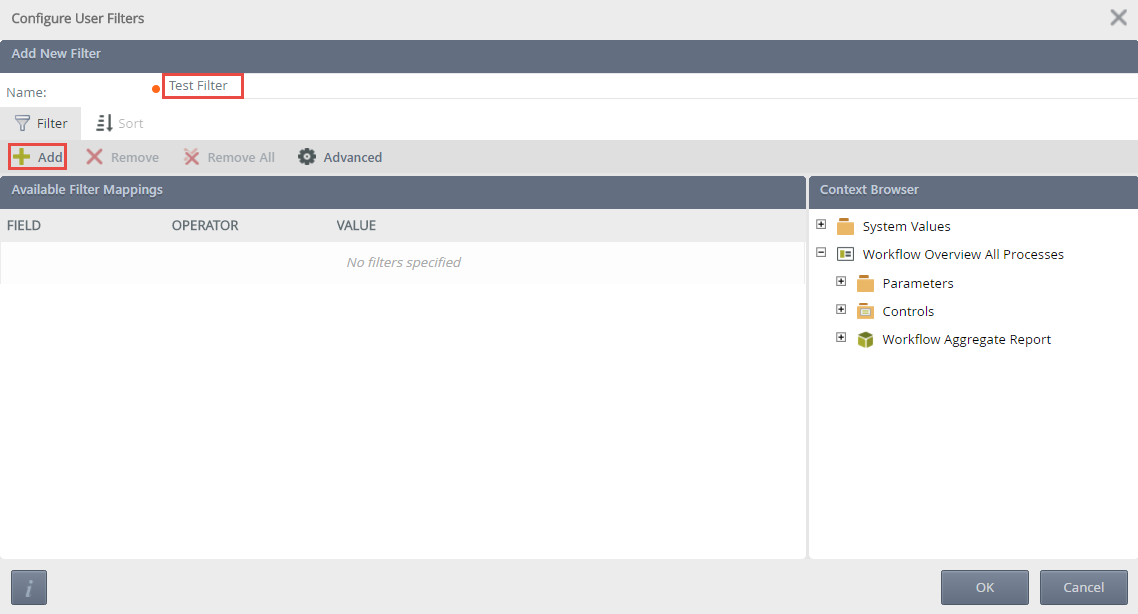
- Provide a Field, Operator and Value. Custom values can be added via the Context Browser.

- Clicking the Advanced button, opens the Advanced Filter Configuration screen.
- Create conditions and expressions if required. Custom values can be added to a condition or expression via the Context Browser. An example of the custom condition is displayed in the Preview.
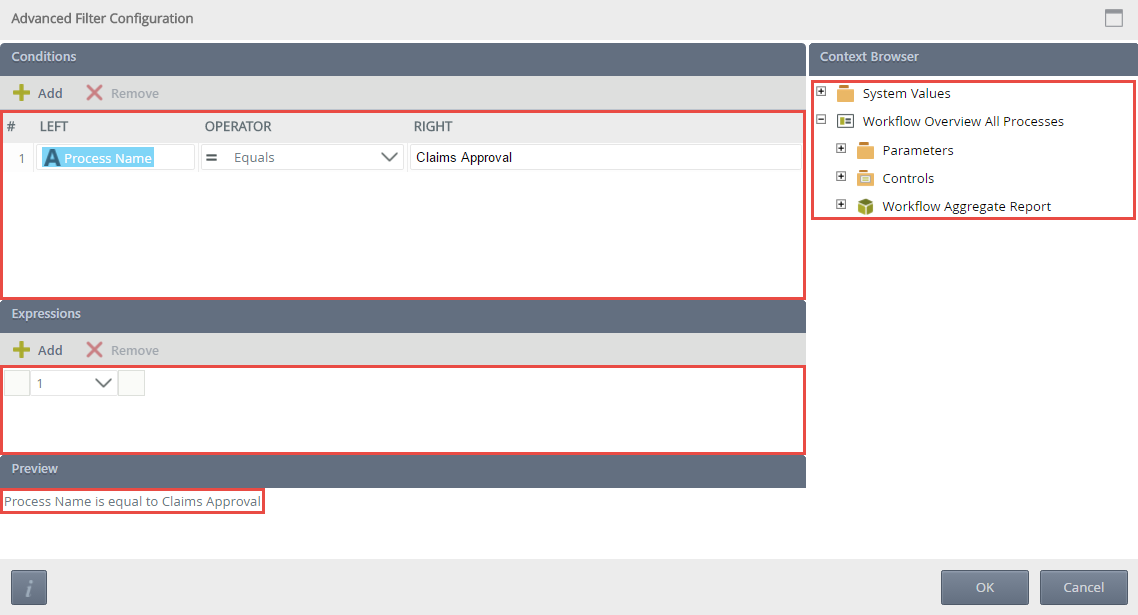
- Click OK.
- On the Configure User Filters screen, click the Sort tab.
- Click Add, and specify a Sort Column and Sort Order. Sort Mappings can be moved via the Move Up or Move Down options. Once the Sort Mapping is complete, click OK.

- On the Configure User Filters screen, Edit, Remove or set the filter as default. Click OK.
- The report section will refresh depending on the default filter selected.
Using the Quick Search
The Quick Search allows you to configure what data is returned on a report section. Selecting an option from the Quick Search drop-down and clicking the Refresh icon will refresh the report section. The options available from the Quick Search drop-down are determined by the column names of the report section.

Custom fields can also be entered, once entered click the Refresh icon and the report loads data based on the search query.
Using the Chart Period
The Chart Period drop-down allows you to further filter returned data by day, week and month.
Follow the steps below user the Chart Period:
- On the report section where the Chart Period is available, click the Chart Period drop-down and select an option.
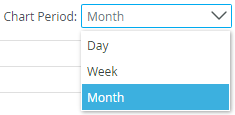
- The report section will refresh with data from the selected Chart Period filter option.
Considerations
Below are considerations when using the All Processes Overview report.
- Editing the color and graph types of the report is not currently possible.
- Exporting the report to Excel and PDF is not currently possible.
- There is no Design Time for this report.